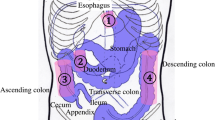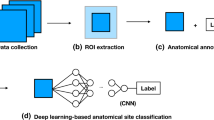Abstract
Background and Aim
Factors influencing reading time and detection of lesions include the view mode (VM) and frame rate (FR) applied during reading of small bowel capsule endoscopy images. The aims of this study were to examine the impact of VM and FR on reading time and lesion detection using a standardized, single-type lesion model.
Methods
A selected video clip containing a known number of positive images (n = 60) of small bowel angioectasias was read using nine different combinations of VM and FR (VM1, VM2, and VM4 × FR10, FR15, and FR25) in randomized order by six capsule endoscopists. Readers were asked to count all positive images of angioectasias (maximum number of positive images, MPIs) seen during reading. The main outcome measurements were effect of VM and FR on reading time and lesion detection.
Results
Mean MPIs for all VM2 and VM4 were 36 (60 %) and 38 (64 %). They were significantly higher than VM1 of 24 (40 %) (P = 0.011, 0.008). A statistical difference was found when the total MPIs at FR10 were compared to FR15 (P = 0.008) and to FR25 (P < 0.001).
Conclusions
Both VM and FR significantly influence lesion detection during capsule endoscopy reading.



Similar content being viewed by others
Abbreviations
- SBCE:
-
Small bowel capsule endoscopy
- VM:
-
View mode
- FR:
-
Frame rate
- MPIs:
-
Maximum number of positive images
References
Levinthal GN, Burke CA, Santisi JM. The accuracy of an endoscopy nurse in interpreting capsule endoscopy. Am J Gastroenterol. 2003;98:2669–2671.
Iakovidis DK, Tsevas S, Polydorou A. Reduction of capsule endoscopy reading times by unsupervised image mining. Comput Med Imaging Graph. 2010;34:471–478.
Rey JF, Gay G, Kruse A, et al. European Society of Gastrointestinal Endoscopy guideline for video capsule endoscopy. Endoscopy. 2004;36:656–658.
Sidhu R, Sanders DS, Morris AJ, et al. Guidelines on small bowel enteroscopy and capsule endoscopy in adults. Gut. 2008;57:125–136.
Spada C, Riccioni ME, Costamagna G. Rapid access real-time device and Rapid Access software: new tools in the armamentarium of capsule endoscopy. Expert Rev Med Devices. 2007;4:431–435.
Shiotani A, Honda K, Kawakami M, et al. Evaluation of RAPID(®) 5 Access software for examination of capsule endoscopies and reading of the capsule by an endoscopy nurse. J Gastroenterol. 2011;46:138–142.
Hosoe N, Rey JF, Imaeda H, et al. Evaluations of capsule endoscopy software in reducing the reading time and the rate of false negatives by inexperienced endoscopist. Clin Res Hepatol Gastroenterol. 2012;36:66–71.
Rey JF, Ladas S, Alhassani A, et al. European Society of Gastrointestinal Endoscopy (ESGE). Video capsule endoscopy: update to guidelines (May 2006). Endoscopy. 2006;38:1047–1053.
Postgate A, Haycock A, Fitzpatrick A, et al. How should we train capsule endoscopy? A pilot study of performance changes during a structured capsule endoscopy training program. Dig Dis Sci. 2009;54:1672–1679.
Postgate A, Haycock A, Thomas-Gibson S, et al. Computer-aided learning in capsule endoscopy leads to improvement in lesion recognition ability. Gastrointest Endosc. 2009;70:310–316.
Faigel DO, Baron TH, Adler DG, et al. ASGE guideline: guidelines for credentialing and granting privileges for capsule endoscopy. Gastrointest Endosc. 2005;61:503–505.
Postgate A, Tekkis P, Fitzpatrick A, et al. The impact of experience on polyp detection and sizing accuracy at capsule endoscopy: implications for training from an animal model study. Endoscopy. 2008;40:496–501.
Günther U, Daum S, Zeitz M, et al. Capsule endoscopy: comparison of two different reading modes. Int J Colorectal Dis. 2012;27:521–525.
Zheng Y, Hawkins L, Wolf J, et al. Detection of lesions during capsule endoscopy: physician performance is disappointing. Am J Gastroenterol. 2012;107:554–560.
Wolff JH, Uradomo LT, Goldberg EM. Wireless capsule endoscopy practice makes perfect? A survey of capsule endoscopy viewing practices in the United States. Gastrointest Endosc. 2009;69:201.
Conflict of interest
None.
Author information
Authors and Affiliations
Corresponding author
Rights and permissions
About this article
Cite this article
Nakamura, M., Murino, A., O’Rourke, A. et al. A Critical Analysis of the Effect of View Mode and Frame Rate on Reading Time and Lesion Detection During Capsule Endoscopy. Dig Dis Sci 60, 1743–1747 (2015). https://doi.org/10.1007/s10620-014-3496-5
Received:
Accepted:
Published:
Issue Date:
DOI: https://doi.org/10.1007/s10620-014-3496-5




